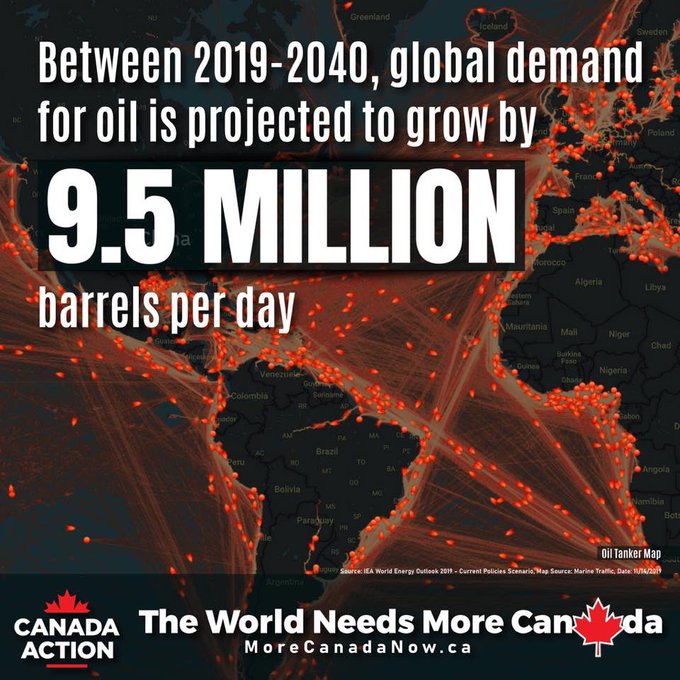Canada should be a global energy supplier of choice because we have the highest standards for protecting people and the planet.
We are 4th in the world on the clean technology index and we should be proud. #MoreCanada 
Alberta
Canada Action on the proposed Teck Frontier Mine

#visionCanada2119
In an effort to help Albertans and Canadians understand each other and have meaningful conversations about energy, the environment, and the economy, Todayville presents this informative post from Canada Action. We invite you to share your questions, comments and concerns. Please note the first time you comment on a Todayville story you will be asked to register as a user. Once registered you are also invited to contribute your own original posts to Todayville’s front page. Thank you for taking part in these important community conversations.

Diagrams and thumbnail photo from Teck.com
From Canada Action
Teck Frontier Mine: 8 Facts You Must Know
With the federal government’s decision on the Teck Frontier Mine coming soon (in February), there’s some important details about this new oil sands project that need to be brought into the limelight.
Teck’s new oil sands mine in northern Alberta will be one of the most innovative projects of its kind to-date, making use of industry-leading technologies to:
> Reduce greenhouse gas (GHG) emissions intensity
> Minimize water use and protect water quality
> Reclaim land as soon as mining begins
> Ensure safe, secure tailings storage with leading-edge technology
> Prevent or mitigate possible impacts to wildlife
Fact #1: Global Oil Demand is Growing
But before we discuss these further, it’s essential we are all reminded of the paramount fact that global oil demand is projected to grow by nearly 10 million barrels per day between now and 2040, as outlined in the International Energy Agency’s (IEA) most recent World Energy Outlook 2019.
Heck, that’s the whole reason why Teck has proposed this massive new oil sands mine in the first place. If oil sands growth forecasts by the Canadian Energy Regulator (CER)and U.S. Energy Information Administration (EIA) come even close to being true, with production increasing 50% by 2040 and even more so by 2050, the new Teck Frontier Mine is just a small part of the puzzle for Canada’s energy industry going forward.
We know about projected growth for oil and natural gas demand in the foreseeable future, so why would anyone not want Canada to have as much market share as possible? As one of the most transparent, regulated and environmentally responsible petroleum producers on the planet, it only makes sense that Canada should be one of the last producers “out of the pool.”
> Canadian Oil is in the World’s Best Interest: ESG Scorecard
> Canada Ranks 6th on Democracy Index 2018 (ESG Criteria)
> Canada Tops Environmental Performance Index Among Top 10 Oil Exporters
Canada’s record of oil and gas production is exemplified by Teck’s initiatives to make Frontier one of the best-in-class oil sands mines ever built in regards to both the environment and Indigenous support.
Fact #2: Land Reclamation Will Begin as Soon as Mining Starts
> Land reclamation will begin as mining progresses, adhering to strict regulations set forth by the Alberta Energy Regulator (AER)
> The actual footprint of active mining will be smaller than the total project area due to on-going reclamation efforts
> With a size of about 292 square kilometres, the mine’s total surface area is about half the size of Edmonton but this land will not be all disturbed at once
Fact #3: Frontier Will Have a Carbon Intensity Less than 50% of USA Refineries

> GHG emissions intensity of the Frontier project will be about 50% less than the oil sands industry average
> Carbon intensity of the Frontier project will be less than half of the oil currently refined in the United States
> Energy efficient mining processes and cogeneration are among the industry-leading technologies that will help reduce GHG emissions
Fact #4: Extensive Work on Prevention & Mitigation for Wildlife
> Extensive assessments of potential effects on fish, wildlife and their habitat have been conducted to ensure the right steps are taken to prevent and mitigate effects during operations and after the mine is closed
> Any affected wildlife habitat will be fully reclaimed to a “…self-sustaining ecosystem with local vegetation and wildlife.” – AER
Fact #5: Frontier Will Have the Lowest Water Use Intensity

> Teck’s Frontier Mine will have one of the lowest water use intensities in the oil sands
> About 90% of water used to process the bitumen will be recycled, minimizing fresh water withdrawals from the Athabasca river
> Off-stream water storage will help to reduce water withdrawals from the river during low flow periods
> Safeguards will ensure water quality is protected and there are no leaks into the water table
Fact #6: Leading-Edge Tailings Management & Technology
> Teck’s Frontier Mine project will use state-of-the-art practices to create a safe and secure placement for tailings
> Centrifuges will de-water tailings fluid before placement mined-out pits, eliminating the need for dams after operations cease and providing increased levels of security for tailings containment in the process
Fact #7: All 14 Indigenous Communities Support the Project

> All 14 Indigenous groups in the region where the Teck Frontier Mine is proposed support the project. They include:
- Athabasca Chipewyan First Nation
- MikisewCree First Nation
- Fort McKayFirst Nation
- Fort Chipewyan Métis
- Fort McKayMétis
- Fort Mc Murray Métis1935
- Fort McMurrayFirst Nation #468
- MétisNation of Alberta- Region One and it’s member locals
- Athabasca Landing Local # 2010
- Buffalo Lake Local # 2002
- ConklinLocal # 193
- Lac La BicheLocal # 1909
- Owl River Local # 1949
- Willow Lake Local # 780
Fact #8: Teck Frontier Mine a Much-Needed Boon for the Energy Sector
> Frontier will employ up to 7,000 people during peak construction
> An additional 2,500 people will be employed throughout operations over a project life of 41 years
> 75,000 person-years of employment generated by the construction of Frontier
> $55 billion generated in provincial taxes and royalties
> $12 billion generated in federate corporate income and capital taxes
> $3.6 billion generated in municipal property taxes
Teck’s investment of $20.6 billion in northern Alberta comes at a time where a lack of new pipeline capacity and strangulating regulations have been choking the life out of one of Canada’s most valuable industries.
Frontier will create thousands of new employment opportunities, tens of billions in government revenues and provide a much-needed boost to an industry that has seen countless jobs and investor cash flee in droves to more competitive oil and gas producing jurisdictions over the past five years.
Much like the Trans Mountain Pipeline expansion, an approval of Teck’s Frontier Mine would help to restore investor confidence in Canada’s energy sector.
With the Trans Mountain Expansion, Keystone XL and Line 3 Replacement set to add more than a million barrels of additional pipeline capacity for Canada in the near future, it only makes sense that this project – with its low carbon intensity and leading-edge environmental initiatives – should provide some of the oil necessary to fill those pipes.
Learn more – Pipelines in Canada: What You Should Know

Canada Action is an entirely volunteer created grassroots movement encouraging Canadians to take action and work together in support of our vital natural resources sector. We believe it’s critical to educate Canadians about the social and economic benefits provided by the resource sector and industry’s commitment to world-class environmental stewardship. We’re strong supporters of Canada’s oil sands and the resource sector generally because we know how important these industries are to Canada’s present and future prosperity.
We’re committed to engaging Canadians in a more informed conversation about resource development, about how important it is to our society and about how we’re doing it well today and improving our practices for the future. We believe that by educating Canadians on the importance of the country’s resource sector – they’ll act on that information, stand up and make their voices count.
Alberta
Alberta Provincial Police – New chief of Independent Agency Police Service

Sat Parhar has been appointed as the first chief of the Independent Agency Police Service, marking the next step toward a new municipal policing option.
The appointment of a new chief for the Independent Agency Police Service (IAPS) marks the next step in giving municipalities a new option for local policing and builds on the work already underway for the agency to assume the police-like duties currently carried out by the Alberta Sheriffs. The IAPS will empower municipalities to adopt strategies that effectively respond to their specific safety concerns, enhancing public safety across the province.
Chief Parhar brings more than 25 years of policing experience, including senior roles with the Calgary Police Service, most recently as deputy chief. His frontline policing experience and deep understanding of Alberta’s complex and diverse public safety landscape positions him to lead the agency as it takes shape and begins its work as a new municipal policing option, keeping communities safe.
Once operational, the agency will strengthen Alberta’s existing policing model and complement the province’s current police services, which includes the RCMP, Indigenous policing services and municipal police. It will help fill gaps and ensure law enforcement resources are deployed efficiently to meet Alberta’s evolving public safety needs and improve law enforcement response times, particularly in rural communities.
“Appointing Chief Sat Parhar is a key milestone in Alberta’s plan to give municipalities a real choice in how their communities are kept safe. This is about building a modern police service that reflects the priorities of Albertans, strengthens local decision-making, and ensures every corner of our province, especially rural areas, can count on responsive, effective law enforcement. With his decades of experience and deep understanding of Alberta’s policing landscape, he is the right leader to bring this vision to life.”
“This appointment signifies a significant step forward in our efforts to establish a more robust, community-focused policing model that is better equipped to meet the unique needs of our local residents. Under Chief Parhar’s visionary leadership, we are confident that we will develop a modern, efficient police service that not only enhances public safety but also aligns closely with the priorities and values of Albertans. His experience and commitment are vital in shaping an IAPS that is responsive, transparent, and dedicated to fostering trust and collaboration within the community, ultimately ensuring a safer and more connected society for all.”
Chief Parhar’s immediate priorities will be to hire an executive team and commence organizational planning such as developing key recruitment, training and other operational policies. Chief Parhar’s appointment is the first step of many to establishing the IAPS.
“It’s an honour to take on this role and help shape a modern police service built for Alberta. My focus from day one will be on setting high standards for professionalism, building strong relationships with our partners and ensuring this service reflects the needs and priorities of the communities we serve.”
The Independent Agency Police Service was formally created through regulation following the passing of Public Safety Statutes Amendment Act, 2024. The agency will operate as an independent Crown corporation, and will be renamed the Alberta Sheriffs Police Service, with its head office located in Calgary. The IAPS will be operationally independent from the provincial government with civilian oversight, consistent with all police services in Alberta.
“When it comes to policing, municipalities like ours deserve a choice – especially when the current system leaves us disadvantaged simply because of our size. We look forward to learning more about what that alternative will look like once an Alberta police agency is fully established and the options are clear. For us, this is about fairness, sustainability, and ensuring municipalities have access to policing solutions that reflect both their needs and their realities.”
Quick facts
- The regulation establishes the IAPS Provincial Corporation and its governance structure including board of directors, board of director powers, financial responsibilities and accountabilities.
Related news
- Expanding municipal police service options (April 7, 2024)
Alberta
Pierre Poilievre – Per Capita, Hardisty, Alberta Is the Most Important Little Town In Canada

From Pierre Poilievre
-

 Alberta2 days ago
Alberta2 days agoAlberta judge sides with LGBT activists, allows ‘gender transitions’ for kids to continue
-

 Crime2 days ago
Crime2 days agoNational Health Care Fraud Takedown Results in 324 Defendants Charged in Connection with Over $14.6 Billion in Alleged Fraud
-

 Health2 days ago
Health2 days agoRFK Jr. Unloads Disturbing Vaccine Secrets on Tucker—And Surprises Everyone on Trump
-

 Business1 day ago
Business1 day agoElon Musk slams Trump’s ‘Big Beautiful Bill,’ calls for new political party
-

 Censorship Industrial Complex1 day ago
Censorship Industrial Complex1 day agoGlobal media alliance colluded with foreign nations to crush free speech in America: House report
-

 Business24 hours ago
Business24 hours agoRFK Jr. says Hep B vaccine is linked to 1,135% higher autism rate
-

 International1 day ago
International1 day agoRFK Jr. tells Tucker how Big Pharma uses ‘perverse incentives’ to get vaccines approved
-

 Aristotle Foundation14 hours ago
Aristotle Foundation14 hours agoHow Vimy Ridge Shaped Canada










You must be logged in to post a comment Login